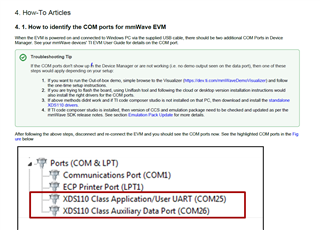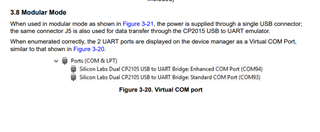Other Parts Discussed in Thread: MMWAVEICBOOST
I am trying to connect and communicate with my AWR6843ISK EVM or run the MMWAVE demo visualizer.
My setup is as follows - AWR6843ISK board by itself(not plugged into a carrier board), USB cable plugged into J5 and connected to PC with the MMWAVESDK installed.
When I plug in the board the following happens:
1) 4 LED's light up on the EVM - power(orange), 5V(green), reset (green) and USB enumerating (green). I also hear the sound indicating a USB device was attached
2) After a few seconds the USB enumerating LED turns off
3) In device manager, I see two new ports but they both show the warning triangle. Instead of showing as XDS110 Class ports, they just appear as "Enhanced Com Port" and "Standard Com Port" with no COM numbers assigned. Device status for these ports says "the drivers for this device are not installed (Code 28)".
This is preventing me from communicating with the EVM.
I have tried the following:
Downloading and installing the both the XDS Emulation Software (32 and 64 bit versions) and the XDS110 Support Utilities from the link below.
https://software-dl.ti.com/ccs/esd/documents/xdsdebugprobes/emu_xds_software_package_download.html
Also have tried to manually update the driver and point it directly to the XDS110 driver at C:\ti\ccs_base\emulation\windows\xds110_drivers
Also tried rebooting the PC, and tried providing external power via TP12 and TP13 - cannot get these ports to be recognized properly.
Do I need an actual version of CCS installed for this to work? The documentation seems to suggest this is not necessary but that seems like the only thing else I know to try.



